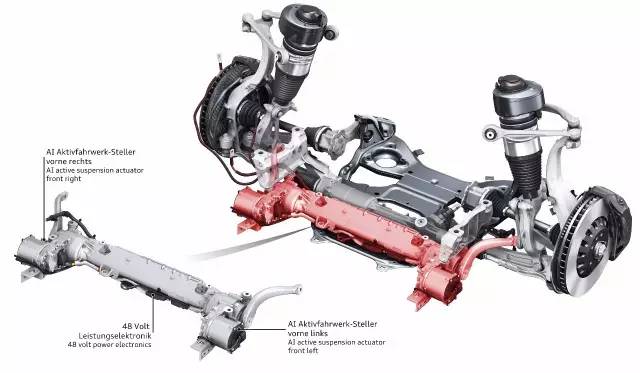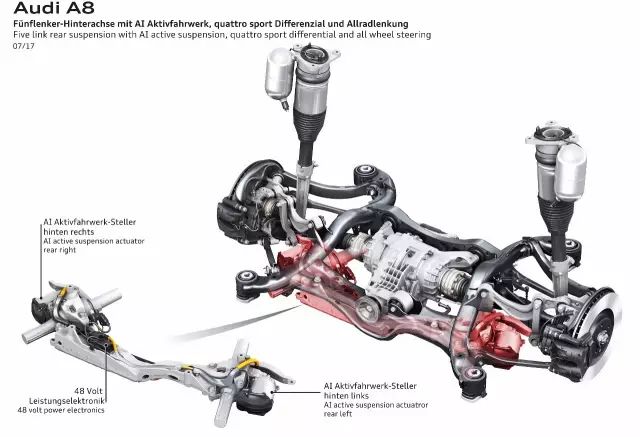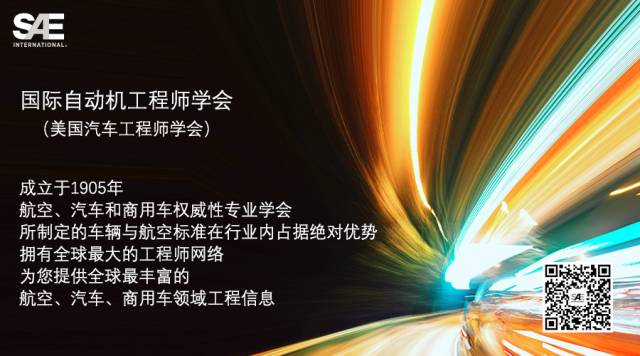 奥迪改用48-V电气系统的举措,被视为是迈向主动悬架之路的关键一步。图为前悬架。
奥迪改用48-V电气系统的举措,被视为是迈向主动悬架之路的关键一步。图为前悬架。 2018款奥迪A8的主动后悬架。
2018款奥迪A8的主动后悬架。
近日,奥迪(Audi)公司发布了全新款A8旗舰款车型,该车最大的特点是可完全调控的机电混合悬挂系统。汽车的前置摄像头会探测路况的各种变化,然后指示主动悬挂系统提前做出反应,以适应最新路况。每个轮子都配有一台电机,由48-V的主电力系统提供能源。悬挂的其他部件还包括传动轮、一根内置钛金属扭力杆的旋管(rotary tube),和一根通过连接杆操控高达1100牛顿·米(811磅·英尺)力矩的控制杆。为此,SAE在英国记者Ian Adcock采访到了负责奥迪A8可变悬挂的悬挂系统研发部门主管Thomas Muller,并带来了这篇独家专题报道。
SAE:在这一悬挂新技术问世后,用户将从中获益什么?
Thomas: 48V电动力引进后,其他很多新技术也随之而来,像电动增压器,或是这款机电混合可变悬挂系统等。这一悬挂系统不必采用液压技术来辅助空气悬挂系统的运作、支撑车体,就可使每个车轮都可以分别上下微调。
这一悬挂同时提升了车辆的乘员舒适度、动力性能以及安全性。我们把底盘这一“大脑”放在一个模块中进行重点研究,而在另一控制模块里,则包括了空气悬挂的信号测定和演算、减震控制、四轮驱动下的后差速器,以及奥迪的主动集成转向系统(active integrated steering system)。如果你想在车里坐得舒服,这一模块就相当重要。
奥迪的主动转向系统(active steering)也是一大突破,将转向齿条、动态转向杆和后桥转向系统整合到同一系统内。同可变悬挂一样,我们相信这一技术也将带来很多驾驶的乐趣。
SAE:所以说这套动态的全轮转向系统也是一项新成果吗?
Thomas: 不错。这一系统让A8的过弯半径缩短到了37.4英尺(11.4米),甚至比A4的38英尺(11.6米)都要短,使汽车在繁忙的都市交通中更显游刃有余。为达成这一目标,我们把后轮的转向调整了5度,这个数字是其它所有竞争对手的两倍。再加上主动悬挂技术,这辆车开起来会让人感觉既舒适,又容易操控——比如汽车变道时,汽车的俯仰振动与翻滚振动明显减少。
全轮驱动改变了之前的后轮必须进一步向后旋转才能减少后排乘客头部横向移动幅度的观点。而有了可变悬挂后,后排乘客将会感觉更舒适。
SAE:主动悬挂系统是如何操控的?
Thomas: 驾驶员辅助系统配有Mobileye单目摄像机,我们用它获取路面的纵向信息,分辨率为1.2到6英寸(约3到16厘米),然后系统会指示底盘控制器,调高或降低悬挂,以应对即将到来的各种路况变化,如:路面车辆减速带或路面坑洼等。
在过弯G力很大时,主动悬挂系统可以使车身侧倾减半,否则车内乘员就会有很明显的感觉。正是这种主动式动态系统的采用,使车辆具备了更高的敏捷性和更好的平衡效果,过去即使是在A8这样的高端车型上,也无法体验到这种效果。这一系统还和车上的预警式侧向传感器相连,对侧面冲击造成的车身高度忽然升高做出及时反应,使车辆在发生碰撞时,由车窗框吸收冲撞能量,而非车门。这样可以使冲击力减少至一半。
SAE:这一系统的反应速度有多快?相关的能量和力有哪集中?
Thomas: 如果看车轮层面的受力,前轮有3.7千牛(832磅力),后轮3.3千牛(742磅力)。不过最重要的一个数据则是每秒每个轮子都可能承受16千牛(3597磅力)的梯度变化。这个力对单个车轮而言非常大,而结合0到6赫兹的信号带宽,意味着每15毫秒就可实现一次产生减震方面的调整。
这个系统同时也很高效。当没有任何能耗时,默认设置会调到空气悬挂系统上;只有当需要进行悬挂调整时,力才会产生。研究表明,在城市驾驶环境中,系统能耗为40到60瓦,在高速公路上则更少,只有10到20瓦,而当遇到路面不平时,能耗为250瓦。即使是在德国纽博格林赛道(Nürburgring),单圈耗能也只有400瓦。这方面的计量并不容易,但这一可变系统的效率应该是液压系统的两到三倍,且梯度更大,带宽更高。
SAE:这一系统是如何安装的呢?
Thomas: 汽车四个角上各有一台2千瓦的电机,通过皮带和OvaloStrain Wave传动轮相连。传动轮的传动比很高,为1:80,通过扭力轴和扭力杆连接到转向节。后轮的情况有所不同,因为后轮无法通过与差速器相连的万向轴。另外,车的前后部都还有功率为48-V的发动机控制单元(ECU),分别和底盘中央控制器相连。
每隔5毫秒,系统生成的信息就会以图片形式显示出路况,并指示如何控制底盘动态起动机构。ADAS系统的前向摄像头(镜头与行驶方向相同)可以解读车辆前方16到65英尺(5到20米)的道路表面数据,然后底盘控制器ECU会对这些数据进行分析,再根据前方道路表面的情况对悬挂系统进行预设。不过即便没有摄像头,整套系统也能运转良好。
SAE:这一技术运用到其他奥迪车型的前景如何?
Thomas: 目前,我们讨论的都是新款A8的情况。不过我觉得这一主动悬挂系统前景一片光明,尤其是在手动驾驶以及“辅助”驾驶的情况下。如果一辆车行驶中没有横向和纵向力,乘员就可以舒服地工作或休息,感觉就像是在一辆高速列车上,这显然是极大的优势。
驾驶的乐趣一直是用户想要的,而舒适感和竞速体验,并非鱼与熊掌不可兼得。让你从繁忙的道路行驶中得到解脱,这正是我们的与众不同之处。
SAE:驾驶员可选的设置有哪些?
Thomas: 奥迪驾驶模式选项(Audi Drive Select)提供了三种设置选项——“舒适”、“自动”和“活力”,分别对应对可变悬挂、全轮转向和四轮驱动的设置。
SAE:奥迪在技术上的合作伙伴是谁?
Thomas: 奥迪没有特定的技术供应商。研发前的工作和概念设想都是由奥迪内部人员完成的,我们也会维护这个阶段的知识产权。之后我们会把工作拆分,找到各环节合适的供应商,一同合作。像Ovalo是转弯模块硬件的主要供应商,大陆集团(Continental)则负责电子硬件方面的供应。
Audi recently unveiled its all-new A8 flagship which now features a fully active, electromechanical suspension system. A front camera detects road irregularities and signals a predictive adjustment of the active suspension to suit the road conditions. Each wheel is fitted with an electric motor powered by the 48-V main electrical system. Additional components include gears, a rotary tube together with internal titanium torsion bar and a lever which exerts up to 1100 N·m (811.3 lb·ft) on the suspension via a coupling rod. In an SAE exclusive, U.K.-based contributor Ian Adcock interviewed Thomas Muller, Audi's head of suspension development on the A8 active suspension.
Q: What are the benefits that customers will experience with this new suspension technology?
With the introduction of 48V it has enabled us to introduce new technologies like the e-Booster and, now, electro-mechanical active suspension with no hydraulics integrated into the system that complements the air-suspension which gives the freedom to raise and lower each wheel independently.
It’s about improving comfort and dynamics and safety. We centralize the chassis ‘brain’ into one module; the signal computing and calculations for the air suspension, damper control, quattro sport rear differential and Audi active integrated steering system are all fed into one control module which is essential if you want to have a smooth interaction with the car.
The Audi active steering is very innovative, integrating the steering rack, the dynamic steering column and the rear axle steering into one system. Together with the active suspension we believe this will deliver a lot of driving pleasure.
Q: The dynamic all-wheel steering system is a new development as well?
Yes. It reduces the A8’s turning circle to less than that of an A4, 38 ft (11.6 m) compared to 37.4 ft (11.4 m), making it easy to maneuver in tight urban confines. We achieve that by turning the rear steering by 5° which is twice that of any rival. Combine that with the active suspension and you have a car that is both very comfortable and maneuverable during lane changing, for example, reducing pitch and roll.
The all-wheel steering shifts the point of rotation further back reducing the rear seat passengers lateral head movement, resulting in a more composed ride when combined with the active suspension.
Q: How is the active suspension system controlled?
We use a Mobileye mono camera from the driver assistance system that generates the vertical information from the road with a resolution of 1.2 to 6 in (3 to 16 cm), signaling to the chassis controller to raise or lower the suspension accordingly when countering upcoming imperfections such as sleeping policemen or pot holes.
Once you get into higher G-forces under cornering, body roll is halved; otherwise it feels very artificial. It’s the combination of the active dynamic systems that result in a level of agility and balance you wouldn’t expect from a luxury sedan like the A8. It is also linked into pre-sense side sensors for side impacts instantly raising the body height, so the sill takes the collision and not the door, reducing the impact by up to 50%.
Q: How fast is the system’s reaction time and what sort of energy and forces are involved?
The forces that we have at wheel level are 3.7 kN (832 lbf) front and 3.3 kN (742 lbf) rear. But the really important figures is that we have a gradient at each wheel of 16 kN (3597 lbf) per second. This is a huge force we can apply at each wheel and, combined with the bandwidth of 0 to 6 Hz, means the damper is being altered every 15 ms.
It’s also an efficient system. Its default setting is on the air suspension system when no energy is consumed; force is only generated when active movement is required. Studies show that in a city environment it consumes 40-60 W, on highways it is even less, 10-20 W, rising to 250 W on rough roads. And even lapping the Nürburgring it’s only 400 W. It’s difficult to quantify but that’s two-to-three times more efficient than hydraulic systems with a higher gradient and bandwidth as well.
Q: How is it set up?
There are 2-kW electric motors at each corner, connected by belt to an Ovalo Strain Wave Gear, that delivers a very high transmission ratio of 1:80 transmitted through a torsion shaft and bar to a link into the steering knuckle. It’s different at the rear because it couldn’t go through the Cardan shaft connected to the differential. Additionally there are 48-V power ECUs front and back networked to the central chassis controller.
Information is generated every five milliseconds to create a picture of what is happening and what needs to be done in controlling the chassis dynamic actuators. Data from the road surface, restricted to 16–65 ft (5-20 m) ahead of the car, is read by the forward-facing ADAS camera and analyzed by the chassis controller ECU to preset the suspension ahead of encountering damaged road surfaces, although it works very well without the camera.
Q: What are the prospects of this technology appearing in other Audi products?
Currently we’re only talking about the new A8. But I think that active suspension will have a bright future, especially the combination of manual and what you might call ‘piloted’ driving. Providing a car that eliminates lateral and longitudinal forces so you can work or relax, like a high-speed train, is a huge benefit.
Driving pleasure is something our customers want: comfort or sporty, it’s not either-or. Allowing you to decouple yourself from the road is a big differentiator for us.
Q: How many driver settings are there?
We have three settings with Audi Drive Select, comfort, auto and dynamic that includes the active suspension, all-wheel dynamic settings and quattro sport.
Q: Who are your technology partners?
We don’t have one technology supplier; pre-development and concept phase was done internally and we keep the IP for that. Then we broke it down and generated a network of suppliers working with us. Ovalo is a main supplier for the corner module hardware and Continental for electronic hardware.
Author: Ian Adcock
Source: SAE Automotive Engineering Magazine
等级
打分
- 2分
- 4分
- 6分
- 8分
- 10分
平均分
- 作者:Ian Adcock
- 行业:汽车
- 主题:零部件车辆底盘与飞机起落架电气电子与航空电子
